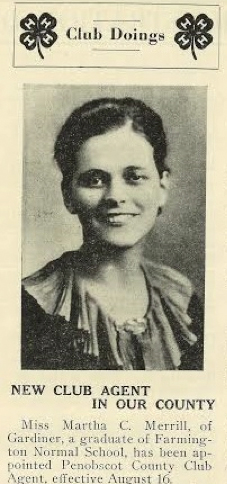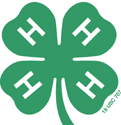4-H Fix: Firsts: Part 2!
Firsts: Part 2!
By Ron Drum, Statewide 4-H Program Professional/Associate Director 4-H Resource Development
Happy New Year! Wait, I said that already, in Firsts: Part 1. So here we go with Part 2!
All of the 4-H FIRSTS reported in Part 1 were happening in Maine and the darn program still wasn’t even officially called 4-H yet! Some places in the country did, others used Junior Extension Club, 3-H Club, Boys’ and Girls’ Club, Young Farmer’s Club, and so forth. By 1915, although Maine was calling them “Boys’ and Girls’ Clubs,” we were already using the 4-leaf clover with an “H” on each leaf for an emblem and following the motto “To Make the Best Better.” In 1919 the Maine Extension newsletter reported that Kansas was using a “dandy” (their word, not mine, although I do agree!) new pledge that began, “I pledge my head to clearer thinking….” It became official nationally when it was approved by the National 4-H Camp in 1927.
In 1917, Gertrude Warren, an educator from New York, joined the Extension Service Staff at USDA. She was a proponent of the name “4-H.” In 1918 she purposefully used “4-H” to describe on-going club work in a national Extension publication, the first time it was so used. So, not surprising, when a meeting was held by the USDA Extension staff in Washington, D.C. in the early ’20s to determine just by what name this work WOULD be called, Gertrude Warren said, “4-H Club Work.” Apparently, the discussion became quite heated but Gertrude held her ground. Read more about Gertrude Warren in the National 4-H Hall of Fame.
In February 1924 Ms. Warren visited Maine. Yes, she visited MAINE in FEBRUARY! She even stayed here for five days, in FEBRUARY. She spent most of those days meeting with the State 4-H team in Orono headed up by State 4-H Leader Lester H. Shibles. However, while here, in FEBRUARY, she also took in some of the countryside, visiting the Hampden Highlands Willing Workers Club led by Mrs. E. E. Wood. Before she returned to Washington, D.C., she sent a “4-H Club Greeting” to all Maine boys and girls club members through the state newsletter Echoes from Clubdom. It began, “It is a pleasure to send a greeting to the 4-H club boys and girls of the Pine Tree State.” That did it. Maine’s program was pretty much called “4-H” from then on!
Ms. Warren must have enjoyed her time in Maine because, just for the record, she returned in 1925 to be one of two special guest speakers, the other being Maine Governor Ralph O. Brewster, during the 12th Maine State 4-H Contest. Date it was held? December 30, 1925 – January 2, 1926. Maybe it was a warm New Years. It happens! Her message? Work hard because “you can’t get something for nothing.”
Communication. It’s important! That’s why, in June of 1919, York County issued the state’s first COUNTY 4-H Newsletter! In his annual report for the fiscal year ending June 30, 1919, County Ag Ext Agent William. M. Gray reported, “…this year we are issuing once each month from May to December inclusive, a little four-page paper called ‘The Club Caller.’ This paper is sent to every leader and club member. Its purpose is to keep each one well posted on the things that are going on among other club members in York County…. Already other counties in the state are considering taking up the same thing.” So here is page 1 of Volume 1, number 1 of the York County Club Caller! But don’t tell anyone. According to the headline, it’s “A SURPRISE”!
 A group of UMaine students who were also former 4-H Members, organized an Orono campus club in 1924 that they called the College 4-H Club. They met for the first time on September 29, 1924 in Lester Shibles’ home. That would be the first Collegiate 4-H Club in Maine.
A group of UMaine students who were also former 4-H Members, organized an Orono campus club in 1924 that they called the College 4-H Club. They met for the first time on September 29, 1924 in Lester Shibles’ home. That would be the first Collegiate 4-H Club in Maine.
The year 1924 also saw the first delegate from Maine attend a National 4-H Club Congress. Velma Jewett of Head Tide was Maine’s representative on the 1924 New England Delegation, chaperoned by Maine’s Assistant State 4-H Leader, Mrs. Arra Sutton Mixter. Montgomery Ward Company paid the expenses. The December 1930 Club Echoes, the newsletter that followed Echoes from Clubdom, noted that Velma Jewett became a Home Economics teacher in Ashland, ME.
National 4-H Conference began as the National 4-H Club Camp in 1927. Maine was present! That first delegation included Norman Hamlin, Turner; Andrew Sawtelle, East Wilton; Lucinda Rich, Charleston; and Lucille Parker, Dover-Foxcroft.
 With all of this happening in 4-H, I’m sure the County Agricultural Agents were becoming a tad overloaded. Relief came in 1928 when Maine finally hired the first Extension Agents who would focus exclusively on 4‑H. Five of them actually: Effie Jones, Kennebec; Evelyn Plummer, Oxford; Martha Corinne Merrill, Penobscot (pictured); Earle T. Blodgett, York; and Kenneth C. “KC” Lovejoy, Waldo. Evelyn Plummer was appointed as Assistant State 4-H Leader 1936-1940. KC went on to serve as the State 4-H Leader 1935 -1963 and then, after he retired in 1963, volunteered as Executive Director for the Pine Tree State 4-H Foundation 1964-1990.
With all of this happening in 4-H, I’m sure the County Agricultural Agents were becoming a tad overloaded. Relief came in 1928 when Maine finally hired the first Extension Agents who would focus exclusively on 4‑H. Five of them actually: Effie Jones, Kennebec; Evelyn Plummer, Oxford; Martha Corinne Merrill, Penobscot (pictured); Earle T. Blodgett, York; and Kenneth C. “KC” Lovejoy, Waldo. Evelyn Plummer was appointed as Assistant State 4-H Leader 1936-1940. KC went on to serve as the State 4-H Leader 1935 -1963 and then, after he retired in 1963, volunteered as Executive Director for the Pine Tree State 4-H Foundation 1964-1990.
Sometimes you just have to get away from it all, get yourself above it all. The Beaver 4-H Clubs of Houlton and Ludlow did just that August 8-11, 1930. They were noted in the September edition of the 1930 Club Echoes (v8, #3) as being the first Maine 4‑H Clubs to climb Mount Katahdin! Twenty-five members, eight guests, and two chaperones were recorded as having made the climb!!
Sometimes you’ve got to find a way to rise above it all and fly even higher! June of 1931, according to the August edition of the 1931 Club Echoes (v14, #2, page 7), saw the first Maine 4-H Club to go for an airplane ride! It was also a first plane ride for all of the passengers!
Eight members of the Scarborough Boys 4-H Club, two members of the girls club, and leaders Mr. F.H.B. Heald, Mr. Elwood Bessy and George Douglass were all “up in the air” in June. …From the Scarborough airport they were taken for a five-minute ride in a five passenger plane piloted by Lieutenant S.B. Chandler, commander of the airport. The club folks had a chance to see their homes and the surrounding territory from the air.
I’m thinking it was a crowded plane ride. I’m counting 13 people listed, not including the pilot, as having taken that ride but note that the plane is described as a “five passenger plane.” Makes me think of MOST of my plane rides! I guess things never change.
And yes, Mr. Heald is the same F.H.B. Heald recognized as Maine’s first 4-H Volunteer and yes, the club is the one noted to be the first Maine 4-H Club. Crowded or not, I’m sure it was quite an experience; one that took a bit of courage to achieve!
If anyone has a photo of either of these events, the Katahdin climb or the Scarborough plane ride, I’d LOVE to include it in a future 4-H Fix!!!
Now, since this is Part 2, we’ll end on a SECOND, February 2 that is, 1962. That’s the day the Pine Tree State 4-H Foundation, now known as the Maine 4-H Foundation, held its first meeting. Yes, on Ground Hog’s Day, reported to have been the coldest day of that winter! The first president elected by the trustees was Claude Clement, a banker and 4-H supporter from Belfast. Mr. Clement was famous in Maine for establishing the Maine Banker’s Association Calf Project, which awarded purebred heifers, “Clement Calves” as they came to be known, each worth approximately $225, to worthy 4-H Members — 75 of them! For that, and his many other philanthropic activities in support of Maine 4-H, Mr. Clement was awarded the National 4-H Distinguished Service Award, which he received during the 1962 National 4‑H Congress in Chicago. He was the first Mainer to receive this award.
What were your 4-H Firsts? Tell me about them, and, if granted permission, I might just include your firsts in a future 4-H Fix!
How about THIS Maine 4-H first? The first Maine 4-H’er to become a national award-winning author! The 4-H Fix will tell her story, the story about JoJo Thoreau, on February 10!
Were you a 4-H Member?
 UMaine 4-H wants to hear your story. Please take a moment to fill out our short form and Tell Us Your Story!
UMaine 4-H wants to hear your story. Please take a moment to fill out our short form and Tell Us Your Story!
University of Maine Cooperative Extension conducts the state’s most successful out-of-school youth educational program through 4-H, a youth development program that has been empowering young people in Maine to reach their full potential since 1913.

